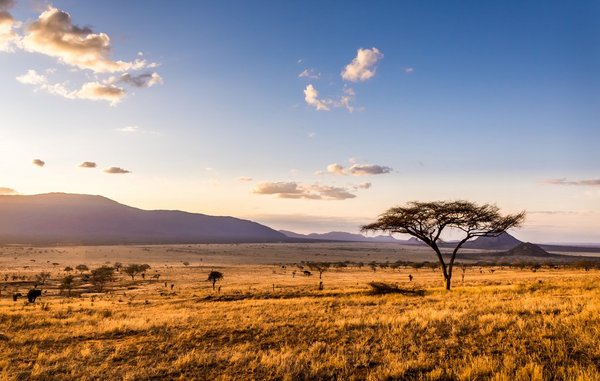- Share this article
- Subscribe to our newsletter
Restoring Africa’s drylands
Drylands harbour a third of Earth’s biodiversity hotspots, and are home to nearly three billion people. They feed half of the world’s livestock, providing livelihoods for hundreds of millions of pastoralists, while 44 per cent of all crops are grown in them. Drylands cover 43 per cent of Africa, and are the habitat of 525 million of its just below 1.4 billion-strong population. A Global Landscapes Forum digital event in June 2021 attended by around 6,600 participants world-wide looked at Africa’s drylands and how they can benefit from integrated restoration practices. According to Robert Nasi, Director General of the Center for International Forestry Research (CIFOR), the restoration of African drylands “is about restoring the balance between people, animals and the environment to sustain productivity in these fragile ecosystems, while supporting aspirations of the next generation for a modern life”.
The two-day conference kicked off with Cinderella Ndlovu, Director and Founder of the Greenhut Trust Youth in Landscapes Initiative, engaging in an “intergenerational dialogue” with Tony Simons, Director General of World Agroforestry (ICRAF) and Executive Director of CIFOR-ICRAF, the event organisers. “I feel that your generation has left the planet in a mess. It has shot it into pieces with its ‘wisdom’. Why are we in this mess?” Ndlovu asked. “I guess it was a combination of arrogance, greed, ignorance and denial. We thought we knew best. We could tame nature and extract all the value we wanted from it at our will,” Simons conceded. “We thought it was a free-for-all, when actually, it was a cost for all.”
Ndlovu emphasised that youth wanted change now, whereas Simons noted that change would take time, also regarding major green infrastructure projects which were already underway. However, he pointed out that with young people outnumbering older people 10:1 on the continent, youth indeed had a crucial role to play. Items the “two generations” agreed on included capacity mobilisation, strengthening youth leadership, inclusive planning and prioritising and financing jobs for nature.
Ibrahim Thiaw, Executive Secretary of the United Nations Convention on Combating Desertification (UNCCD), highlighted the crucial role of the drylands in agriculture, including inland fisheries, and dispelled claims that these areas were not productive. Regarding climate change, drylands contained large open spaces acting as carbon sinks. And far from not being worth investing in, drylands offered opportunities for extractive industries, were sources of healthy products which changes in dietary habits were creating a new market for, had a huge clean energy potential and presented a wide range of options for tourism. Thiaw rejected claims that people in drylands were deliberately destroying their environment, arguing that in their fragile and vulnerable habitat, people were water-efficient and made careful use of natural resources.
UN Decade on Ecosystem Restoration
Inger Andersen, Under-Secretary-General of the United Nations Environment Programme (UNEP), noted that the launch of the UN Decade on Ecosystem Restoration shortly after the GLF conference was coming at a critical moment. The Decade aims to accelerate action to protect, halt and reverse the degradation of ecosystems world-wide, including grasslands and savannahs, peatlands, forests, farmlands, mountains, freshwater, coastal and marine ecosystems and urban areas. “We are in the middle of a triple planetary crisis: the climate crisis, the biodiversity and nature crisis, and the pollution and waste crisis. Unless we act, these waves of disruption and waves of suffering which we have seen with COVID will be very little compared to what we will see here,” Andersen warned.
Now was the time to provide finance and put incentives in place to adopt inclusive wealth models valuing nature and promoting investment. Legislation had to be introduced to change prevailing agricultural practices favouring destroying ecosystems through negative practices such as forest clearing. Nature-positive agriculture had to be incentivised, and funds needed to be allocated to restoration in COVID-19 recovery measures. Consumers had to be able to make sure that they were buying deforestation-free products.
Maria Flachsbarth, Parliamentary State Secretary to Germany’s Federal Minister for Economic Cooperation and Development, noted that the German Government was supporting the UN Decade with both a national campaign and numerous international projects. “We are convinced that a world without hunger is possible within the planetary boundaries,” Flachsbarth said, and called for a transformation moving away from systems harming the environment and society towards sustainable systems. She emphasised the role of holistic rural development based on a multisectoral, integrated approach to spaces, developing good interaction between communities, business and nature at a regional level and, in particular, building on local knowledge and tradition.
Referring to African drylands in particular, Flachsbarth said that regional economic activity, production and productivity had to be increased, e.g. through agro-ecological measures. Resources such as soils, forests and bushlands were in need of rehabilitation and conservation, while adapting to climate change also included diversification and promotion of resilient species. Fair access to land was needed, and in particular, wherever animal husbandry came into play, a One Health approach addressing humans, animals and the environment was paramount.
Farmer-led restoration
One of the focal topics at the conference was farmer-led landscape restoration. Jes Weigelt, Head of Programmes at TMG – Think Tank for Sustainability, pointed out the risk of large-scale restoration processes alienating those whose livelihoods depended on land. Patricia Kombo, founder of the PaTree Initiative in Kenya, highlighted the importance of working together with the communities and above all getting young people involved, and enabling them to appreciate nature. “Landscape restoration cannot be achieved at scale without engaging farmers and communities in the restoration process, especially at its beginning,” said Leigh Winowiecki, Leader of Land Health Decisions at ICRAF, explaining that embedding co-learning into landscape restoration was vital to accelerate impact on the ground and increase ownership in the process.
Mike Gardner, Journalist, Bonn Germany
Read more at Global Landscapes Forum website





Add a comment
Be the First to Comment